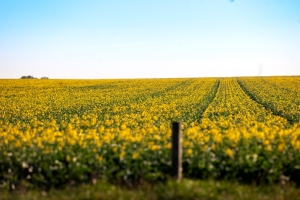Early sown canola an option where there is stored soil moisture
Author: Toni Somes | Date: 08 Apr 2020

New South Wales grain growers with good stored soil moisture levels following the recent rain should consider early sowing of longer season canola varieties after new research demonstrated their capacity to utilise deep water to yield well in a tough finish.
And for those who missed out on summer rain and still have dry soil profiles, it may be wise to reconsider these early-sown crops in favour of those that can yield well from a later sowing.
This is the advice of CSIRO researcher John Kirkegaard, who presented his research on ‘canola’s deep roots and agronomy to capture benefits and manage legacies’ at a recent Grains Research and Development Corporation (GRDC) Grains Research Update in Wagga Wagga.
The specialist farming systems researcher has also shared his Updates presentation in a new GRDC podcast, detailing the results from the key research which for the first time accurately measured the maximum depth and efficiency of canola roots.
-
GRDC PodcastPodcast
GRDC Podcast: Early sown canola digs deep
New research has shown just how deep canola roots will travel in their search for moisture late in the season. In this podcast CSIRO’s John Kirkegaard reveals just how low canola roots go and the benefits that can be derived from early sown canola.
Date: 01 Apr 2020
Dr Kirkegaard said long season canola had proved it could yield well in dry seasons thanks to root systems capable of accessing soil moisture at depths of three to four metres.
But he urged growers, who might be deliberating about whether to try longer season varieties, to consider their agronomic and crop rotation consequences – in particular how much moisture would be available to subsequent crops.
“What we found during trials in the very dry periods of 2018 and 2019, where we had some summer fallow rain pre-crop but limited falls during the season, was that we could capitalise on stored moisture by sowing canola earlier,” Dr Kirkegaard said.
“These earlier sown varieties have time to develop deeper roots that can capture stored moisture late in the season which is really important for yield. But importantly these varieties will still flower at the right time to miss the heat and frost.
“In the past four or five years these slower maturing varieties have really come into their own in terms of their yield advantage, because we have had some summer rain giving us deep stored moisture, while our springs have been hotter and drier.”
The trials built on work conducted as part of the Optimised Canola Profitability project, a collaborative research project with co-investment from the GRDC, CSIRO and NSW DPI which investigated the potential for early sown canola – from northern New South Wales to the Eyre Peninsula.

Dr Kirkegaard said brassicas had a reputation for deep roots, but until now research in Australia had not accurately quantified their maximum depth and water uptake.
“We found a range of varieties were growing roots down at a rate of about two centimetres per day from sowing to flowering, and after flowering the rate slowed to about 1-1.5cm/day. These roots ended up growing down to about three to four metres in soils of sufficient depth,” he said.
Dr Kirkegaard said in drier seasons deep stored water had proven to be ‘liquid gold’ in farming systems and the long season canola varieties had shown they were capable of accessing deep water with high efficiency.
“We have seen longer season canola drawing up 25-30 millilitres of water from a depth greater than 2m below the soil surface, generating yield increases of up to one tonne per hectare. This is really impressive water use efficiency (30-40 kg/ha/mm) for that deep water, and is around double the efficiency we would expect from a total seasonal water (10-15 kg/ha/mm).
“Longer season canola grown in more than 20 trials in 2017 and 2018 achieved, on average, an 0.4t/ha yield advantage from this early sowing system, with total yields ranging from 1.0 to 3.5 t/ha.”
Dr Kirkegaard said shorter season canola sown in the ideal window (early May) was also able to match the yield performance of longer season varieties, but only in wetter seasons when deep water was not called upon to support high yields.
“Shorter season canola roots grow at a similar rate to those of longer season varieties, yet because they are growing for a shorter time they don’t get as deep. However, the depths of about 2m reached by the shorter season canola varieties is still impressive when compared with crops like cereals and pulses,” he said.
Yet he warned the trade-off for planting canola varieties with deep seeking roots was drying out the soil profile at depth and growers needed to understand the legacy effects.
“If the profile fails to fill up over summer, the dry soil following early-sown canola can be managed by growing crops such as barley, grain legumes or shorter season wheats that perform with a later sowing, allowing time to capture additional moisture,” he said.
“If you have dry soil following early canola you may need to think about changing your crop sequence and your sowing date.”
Dr Kirkegaard said other agronomic considerations were ground cover levels. If cover was adequate, a grain legume could be a sowing option, and if cover was limited, a barley or cereal crop might provide an adequate level of ground cover to protect the soil and preserve moisture.
In addition to the podcast, practical agronomic advice is available in the publication 20 tips for Profitable Canola.
Contact Details
Contact
Toni Somes, GRDC Communications Manager – North
0436 622 645
toni.somes@grdc.com.au
GRDC Project Code: CSP00187,
Was this page helpful?
YOUR FEEDBACK


